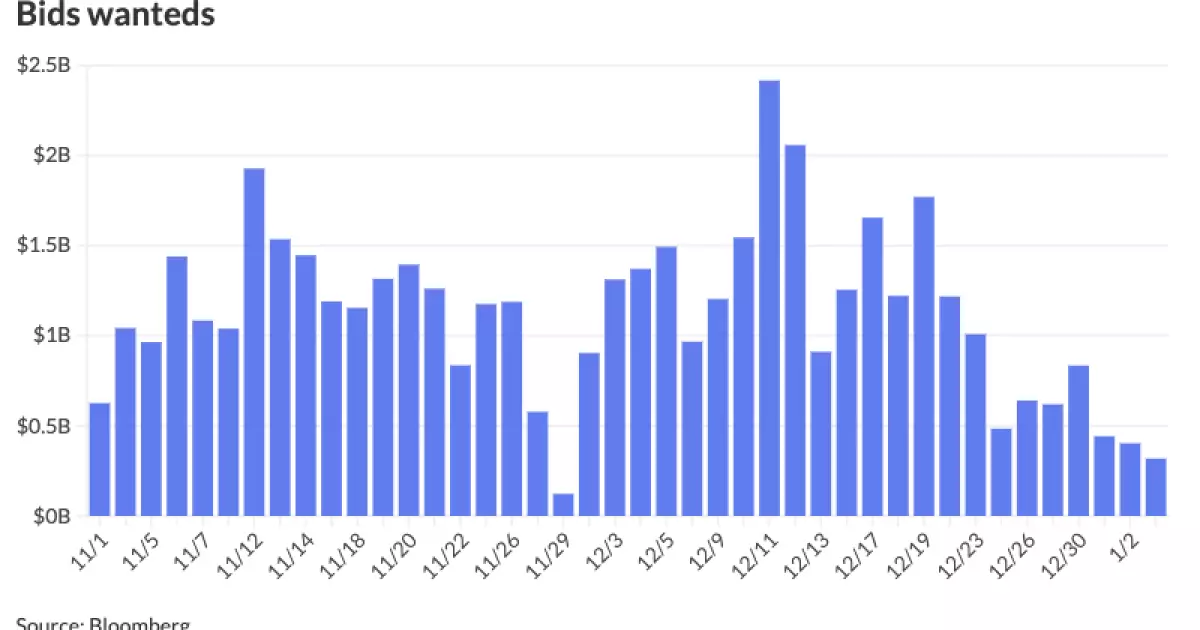The municipal bond market is currently exhibiting a relatively steady tone, despite facing minor fluctuations in United States Treasury yields and mixed performances from equities. The recent activity has highlighted pivotal changes in municipal to U.S. Treasury (UST) ratios, creating a narrow yet impactful space for investors to observe—especially as the end of 2024 approached. The landscape is further characterized by an intriguing intersection of steady municipal yields and the pressing pressures of tax-related trading which set the stage for market dynamics in early 2025.
As of recent trading, municipal bond ratios displayed slight declines—The two-year ratios resting at 65% and the 30-year at 80%, indicating a tightening market environment. The diminishing yields signify both stability and strategic positioning for reinvestment opportunities that are expected to emerge as we advance into January. According to J.P. Morgan, these market upticks near year-end can entice investors looking for favorable entry points to capitalize on reinvestment capital. The immediate challenge that looms, however, is the interaction between supply dynamics and the Federal Reserve’s evolving fiscal policy, which could introduce volatility in future market activities.
Moreover, December experienced a notable sell-off in the fixed-income segment, an unusual occurrence for the month. Daryl Clements from AllianceBernstein emphasized the significance of these trends, marking the third week of December as particularly volatile while highlighting the eventual stabilization that transpired during the Christmas week. While recent gains indicated a minor boost in municipal performance, the overall performance decline of 1.46% throughout December raises concerns regarding persistent outflows, which Clements attributed to tax-loss harvesting strategies among investors.
As we transition into 2025, the expectations surrounding supply and issuance levels are notably mixed. After experiencing record issuance levels topping $500 billion in 2024, the latter part of the year saw a stark decline, with only a modest $4 billion being introduced in the final three weeks. In the initial week of 2025, investors are primed to face a heightened supply of approximately $5.18 billion. This anticipated supply may propel renewed interest in the market, reflecting a rebound from previous low issuance valuations. Notably, though, the upcoming supply level remains significantly below the previous patterns witnessed throughout 2024.
Market strategists speculate that issuance for 2025 could hover around the $500 billion mark, with potential for even higher volumes as various issuers seek to take proactive measures concerning looming changes to tax exemptions. Congress’s imperative to address the $4 trillion deficit associated with the expiring Tax Cuts and Jobs Act plays a crucial role in shaping these dynamics. The market may experience strain from this influx, yet existing yield rates remain attractive, particularly with the current Index yield resting at an appealing 3.70%.
Investment strategies amidst evolving economic circumstances will need to account for a projected normalization of the municipal yield curve, a process expected to gather pace as the Federal Reserve contemplates continued rate cuts. Income generation is expected to remain a focal point for investors in 2025, underscored by the strong credit fundamentals suggesting solid recoverability and sustainability of municipal bonds. Notably, the median rainy-day fund balance for 2025 stands at an impressive 14.4% of general fund revenues—an indication of strong fiscal health.
Clements highlights the likelihood of lower-rated bonds achieving better performance than their higher-rated counterparts, predominantly driven by excess carry rather than significant spread compression. This evolving credit quality environment suggests that investors may need to recalibrate their risk assessments and investment horizons to maximize returns while managing potential volatility in the municipal bond market.
The municipal bond market faces a unique confluence of opportunities and challenges as it navigates the complexities associated with rising yields and changing fiscal policies. While the immediate outlook is characterized by potential gains and stabilization following last year’s fluctuations, the market dynamics anchored by ongoing supply issues and shifting investor sentiment necessitate a prudent approach. As investors gear up for the new year, an astute understanding of the upcoming trends and a flexible strategy will be vital for capitalizing on the alluring but unpredictable landscape of municipal bonds. Addressing these complexities head-on will determine the trajectory of investor confidence and the overall efficacy of the market in the year to come.

